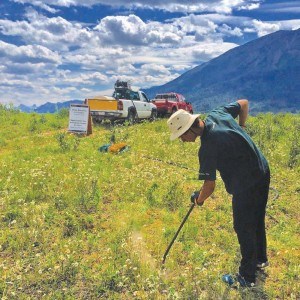
Jasper National Park has been blessed with amazing scenery, plants, and animals, but sometimes even Mother Nature needs a little help.
Soil compaction, tree damage, or even just the natural cycles of aging, disease, or insects can take a toll on the scenery and health of an area. However, there is a special Parks Canada crew that helps restore the park, preserving its stunning reputation for future generations to enjoy.
The vegetation restoration crew is made up of a Parks Canada staff member working with nine university students and seven local high school students and they work in collaboration with partners, including the Town of Jasper.
By working together, their accomplishments in Jasper National Park’s campgrounds, trails and around the community are impressive. Around the Whistlers, Wapiti, and Wabasso campgrounds, approximately 1,450 trees and about 1,100 shrubs were planted last year. Roughly half of those trees were transplanted Douglas fir from the Pyramid fire guard.
Normally those trees would be slated for mechanical and fire removal as part of the townsite fireguard maintenance but instead they were transplanted by the restoration crew. This program has great ecological benefits as trees transplanted from within the park are already well adapted to growing here. They have native root/fungus associations and therefore sapling survival is much higher than using nursery grown trees.
By industry standards, a 50 per cent success rate on transplanting trees could be considered good, but the follow-up transplant survey in Jasper found survival to be above 90 per cent.
Mature Douglas fir is long lived and fire resistant. Given that Jasper has the most northern population of Douglas fir in the Alberta Rockies, it is a tree that Parks Canada wants to see expand and use in high profile locations such as Whistlers campground. Campgrounds are optimal locations for creating future screening and aesthetics, as well as developing small animal habitat amongst the campsites.
The restoration crew also works on revegetating high use areas, helping improve and define desired trails while returning areas to a more natural state.
Implementing restoration for the Jasper Trails Plan is an ongoing priority for the crew. Last year’s work included reclamation of an important wildlife corridor on the slopes of Whistlers Mountain.
Another example in partnership with the Town of Jasper is Operation Green Shield. This effort includes both invasive weed removal as well as replanting damaged areas.
The east end of the Discovery Trail at the eastern end of town is a great demonstration of a long term restoration strategy succeeding. The goal is to develop a line of Douglas fir tree cover that makes the ground underneath less receptive to weeds while providing aesthetics for trail users and a visual buffer from the rail yard.
The continuous field of tall mustard that had established from the rail yard is now primarily native species, and the trees are thriving thanks to an underground watering system.
Technology is also helping the restoration crew. A new weed steamer that was acquired last year is being used to kill some invasive weeds but more importantly the device is used to sterilize weed seed near the soil surface in areas that have been colonized by invasive non-native plants. This means not having to return over and over again to weed infestation sites, which is important when you consider one mustard plant can produce 80,000 seeds per season.
The steamer is an especially important tool in the Jasper townsite where herbicides have been banned for domestic use, providing an alternate tool to deal with invasive weeds that doesn’t have residual effects on vegetation or in the soil.
If you would like to help Parks Canada improve the health and aesthetics of native vegetation in the park, you can contact Kevin Gedling, our volunteer coordinator, at [email protected] to participate in one of our many restoration projects this summer.
Parks Canada
Special to the Fitzhugh

